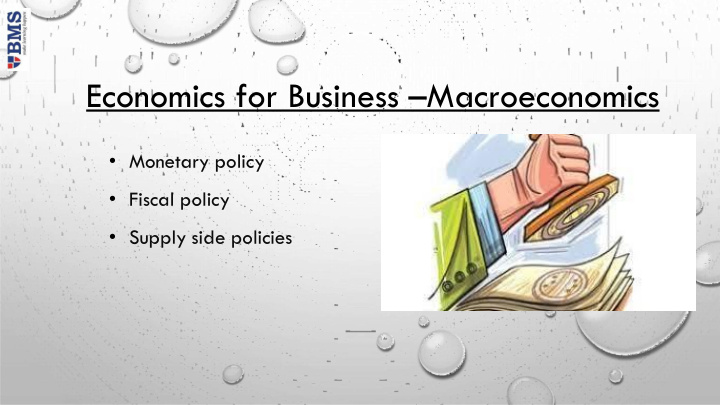



Economics for Business – Macroeconomics • Monetary policy • Fiscal policy • Supply side policies
Monetary Policy • This is a demand side policy designed to influence the aggregate demand of the economy. • Involves changing interest rate & money supply. • Usually controlled by the monetary policy committee of the central bank. • Ideally should be independent from the government and is usually used to control the inflation level in the economy.
Types Of Monetary Policy • Expansionary Monetary Policy – Involves reducing interest rates & increasing money supply in the economy. Causes an increase in aggregate demand. • Contractionary Monetary Policy - Involves increasing interest rates & decreasing money supply in the economy. Causes an decrease in aggregate demand.
Interest Rates • The price for the use of money • The cost of borrowing money • The reward for lending money Interest can also be viewed as : • A return for sacrificing liquidity • A fee for risk • Compensation for inflation 4
Nominal And Real Interest Rates • Nominal rates are the % paid on the loaned amount • Real rates adjust for inflationary effects Real Rate = Nominal Rate- Inflation Rate 2% = 6% - 4% • Lenders make decisions on the real rate 5
Factors Affecting Interest Rates 1. Supply of funds (savings/deposits) Interest rates are determined by • Domestic savings(by household & firms) demand and supply of funds in • Foreign loans money markets • Monetary policy’s influence on supply of cash 2. Demand for funds (borrowing) • By firms for investment • By households for consumption • By governments to finance budget deficits 3. Inflation Savers demand real returns Lenders will not lend if real rates are too low Rates reflect expected inflation 6
Factors Affecting Interest Rates 4. Level of overseas rates • International investors have a global approach - look for highest returns 5. Monetary policy - market operations • By buying or selling government securities the Central Bank can move rates • Cash rates move first 7
Effects Of High IR – Contractionary Monetary Policy. Consumers: • Consumption discouraged (E.G. Higher credit card interest, higher home loan repayments) • Savings ↑ Business Investment discouraged (Higher repayments/costs of loans, projects less profitable) 8
Effects of High Interest Rates Cont. • Less consumption • Less investment • More savings • Less AD and reduced economic activity Contraction of economy • Higher unemployment • Lower inflation (lower demand pressure) • Lower GDP growth 9
Fiscal Policy • This is a demand side policy designed to influence the aggregate demand of the economy. • Involves changing taxation & govt. Spending. • Controlled by the government budget • Used to achieve the government objectives
Types Of Fiscal Policy • Expansionary Fiscal Policy – Involves reducing taxes & increasing govt. Spending in the economy. Causes an increase in aggregate demand. • Contractionary Fiscal Policy - Involves increasing taxes & decreasing govt. Spending in the economy. Causes an decrease in aggregate demand.
The Budget A statement setting out the govt. Estimated expenditure (G) and revenue (T) for the forthcoming financial year. It contains details on: 1. Recent economic performance 2. Overall stance or aim of policy 3. Specific planned measures 4. Expected effects 13
Functions of Fiscal Policy • Allocation of resources - To affect output and resource use inthe economy How?- Taxes on selected goods and services E.G. Alcohol, cigarettes - Subsidies, tax concessions E.G. Health care, education, child care - Govt. Spending on public goods E.G. Defense 13
Functions of Fiscal Policy • Redistribution Of Income • To Influence The Way In Which Goods And Services Are Shared Aim? Less Income Inequality How? rates for -Different tax rates e.G. Higher tax higher income earners - Social security, welfare payments - Spending on health, education, etc. 14
Direct And Indirect Direct Tax • Paid directly from the tax payer to the govt E.G. Income tax, company tax Indirect Tax • Tax is collected from one source but the burden is passed on to another (consumer) E.G. Excise on petrol, Tariff 15
Financing a BudgetDeficit Deficit : Govt. Spending > Tax Revenue • Used to stimulate economic activity • Govt. is spending more than it receives • Needs to finance the difference – the Public Sector Borrowing Requirement (PSNCR) • Federal, states, local govt. plus government authorities and govt. businesses Adds to Public (National) Debt 21
Methods of Financing the Budget Deficit Borrowing from domestic economy • Borrowing by govt. Uses a proportionof domestic savings • Funds available for firms to borrow reduced • Competition for funds puts upward pressure on interest rates 18
Methods of Financing the Budget Deficit Borrowing from overseas • Foreign banks, foreign investors • Adds to foreign debt • Can cause currency to appreciate • Repayment of interest can ↑ current a/c deficit Borrowing from the reserve bank • Central bank provides funds for government to spend • Printing money 19
Current National Debt is around $55 Billion .
Positive Aspects of Budget Deficit May stimulate economic activity • Keynesian policy concept • Injection of demand • Multiplier effect • Should be used when economic activity is below target growth rate. 21
Negative Aspects of Budget Deficits • Deficits may be inflationary • Crowding out effect • Pressure on interest rates • Increased size of govt. Sector at the expense of private sector • Debt accumulated for future 22
Budget Surplus • Used when economic activity is higher than desired - boom • Can be used to increase national savings Impound the surplus – keep excess funds out of circulation Reduce national debt – pay back govt. Debt by buying back securities from private sector Repay foreign debt – the govt. Component 23
Recommend
More recommend